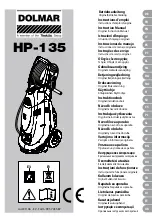
8
Garments are labeled "Hand Wash" because:
■
The fiber or construction may be sensitive to agitation.
■
The fabric contains sensitive dyes that may bleed.
NOTE: Some "Hand Wash" items, particularly wool, naturally
shrink when washed. Keep this in mind when you purchase items
labeled "Hand Wash."
Properly sort and then use your Hand Washables cycle for gentle
washing. If items appear to be floating due to trapped air, stop
the washer by pushing in the Cycle Control knob. Push items
down into the water. Restart the washer by pulling out the Cycle
Control knob. Follow care label directions for drying. Items that
may shrink should be dried flat. When still wet, block these items
by gently stretching to original measurements.
Extended Soak cycle
The Soak cycle features a brief period of agitation and soak time
to remove heavy soils and stains that need pretreatment. The
soak period will continue as long as you like. Thirty minutes or
less is recommended for most loads.
■
Use warm water when soaking laundry. Hot water can set
stains.
■
Use the amount of detergent and presoak additive
recommended by the manufacturer.
■
When you have decided to end the Soak cycle, turn the Cycle
Control knob to Prewash or Spin (to drain the water).
■
Add detergent and select a new wash cycle.
Prewash cycle
This cycle features a brief period of high-speed agitation to help
remove heavy soils and stains that need pretreatment. Use warm
water for prewashing stained laundry. Hot water can set stains.
After the Prewash cycle ends, add detergent and select a new
wash cycle.
Stain Removal Tips
Stained or heavily soiled items may need to be prewashed or
soaked for best results. Soaking helps remove protein-type
stains such as blood, milk, or grass. Prewashing helps loosen soil
before washing.
■
Use cold or warm water for soaking or prewashing stained
laundry. Hot water can set stains.
■
Most stains are easier to remove when they are fresh. Old or
set stains may not come out. Follow package directions for
pretreatment products.
■
Before treating any stain, find out what kind of stain it is, how
old the stain is, what kind of fabric it is, and if the fabric is
colourfast. (Check the care label.)
■
When bleach is recommended, use a bleach that is safe for
the fabric.
■
Test stain removers on an inside seam or hidden corner of the
item to see if the colour is removed.
■
Put the stained area face down on a paper towel or white
cloth. Apply the stain remover to the back of the stain. This
forces the stain off the fabric instead of through it.
■
Meat tenderizer or enzyme presoaks help break down some
protein stains so they are easier to remove.
■
Washing and drying can set some stains.
Extra Rinse and Spin
When using extra detergent for heavily soiled clothes, or washing
special-care items, you may find an extra rinse and spin is
needed.
1. Push in the Cycle Control knob and turn it clockwise to any of
the Rinse settings.
2. Pull out the Cycle Control knob. The washer fills to the
selected load size, agitates, drains, and spins.
NOTE: An EXTRA RINSE option is available (on some models).
See “Starting Your Washer.”
Drain and Spin
A drain and spin may help shorten drying times for some heavy
fabrics or special-care items by removing excess water.
1. Push in the Cycle Control knob and turn it clockwise to any of
the Spin settings.
2. Pull out the Cycle Control knob. The washer drains, then
spins.
Adding Liquid Bleach
Always measure liquid bleach. Do not guess. Never use more
than 250 mL (1 cup) for a full load. Follow manufacturer’s
directions for safe use. Use a cup with a pouring spout to avoid
spilling.
1. Let the washer fill and begin agitating the load.
2. Add bleach to the wash cycle so it can be removed in the
rinse cycle. Pour bleach around the agitator, not directly on
the load.
■
Follow directions on the care labels. Do not use liquid
bleach on wool, silk, spandex, acetates, or some flame-
retardant fabrics.
■
When soaking with liquid bleach, add detergent to soak
water.
NOTE: Undiluted bleach will damage any fabric it touches. The
damage appears as rips, holes, tears, or colour loss and may not
show up until several washings later.
Adding Liquid Fabric Softener
Always dilute fabric softener with 125 to 250 mL (½ to 1 cup)
warm water. Undiluted fabric softener can stain fabrics.
■
Add diluted fabric softener only in the final rinse.
■
Fabric softener should not be mixed with other laundry
products. Greasy stains can form. To remove greasy stains,
wet the stain and rub with liquid detergent or a bar of soap.
Rewash.
■
Too much fabric softener can make some items (diapers and
towels) nonabsorbent. If this happens, use less fabric
softener, or do not use it every time.






























